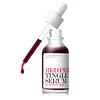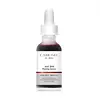What's inside
What's inside
 Key Ingredients
Key Ingredients

 Benefits
Benefits

 Concerns
Concerns

 Ingredients Side-by-side
Ingredients Side-by-side

Water
Skin ConditioningGlycolic Acid
BufferingButylene Glycol
HumectantGlycerin
HumectantSodium Hydroxide
Buffering1,2-Hexanediol
Skin ConditioningXanthan Gum
EmulsifyingGaultheria Procumbens Leaf Extract
PerfumingLactic Acid
BufferingGardenia Jasminoides Fruit Extract
Cosmetic ColorantVaccinium Myrtillus Fruit Extract
Skin ConditioningCitric Acid
BufferingEthylhexylglycerin
Skin ConditioningDisodium EDTA
Rubus Idaeus Fruit Extract
AstringentCaprylic/Capric Triglyceride
MaskingPortulaca Oleracea Extract
Skin ConditioningRubus Fruticosus Fruit Extract
AstringentSucrose Distearate
EmollientPhyllanthus Emblica Fruit Extract
HumectantEuterpe Oleracea Fruit Extract
Hydrogenated Lecithin
EmulsifyingPolyglyceryl-10 Oleate
Skin ConditioningCholesterol
EmollientGlycine Soja Oil
EmollientSodium Hyaluronate
HumectantPhenoxyethanol
PreservativeStearic Acid
CleansingPhytosphingosine
Skin ConditioningCeramide NP
Skin ConditioningGlyceryl Citrate/Lactate/Linoleate/Oleate
EmulsifyingCeteareth-20
CleansingWater, Glycolic Acid, Butylene Glycol, Glycerin, Sodium Hydroxide, 1,2-Hexanediol, Xanthan Gum, Gaultheria Procumbens Leaf Extract, Lactic Acid, Gardenia Jasminoides Fruit Extract, Vaccinium Myrtillus Fruit Extract, Citric Acid, Ethylhexylglycerin, Disodium EDTA, Rubus Idaeus Fruit Extract, Caprylic/Capric Triglyceride, Portulaca Oleracea Extract, Rubus Fruticosus Fruit Extract, Sucrose Distearate, Phyllanthus Emblica Fruit Extract, Euterpe Oleracea Fruit Extract, Hydrogenated Lecithin, Polyglyceryl-10 Oleate, Cholesterol, Glycine Soja Oil, Sodium Hyaluronate, Phenoxyethanol, Stearic Acid, Phytosphingosine, Ceramide NP, Glyceryl Citrate/Lactate/Linoleate/Oleate, Ceteareth-20
Ingredients Explained
These ingredients are found in both products.
Ingredients higher up in an ingredient list are typically present in a larger amount.
1,2-Hexanediol is a synthetic liquid and another multi-functional powerhouse.
It is a:
- Humectant, drawing moisture into the skin
- Emollient, helping to soften skin
- Solvent, dispersing and stabilizing formulas
- Preservative booster, enhancing the antimicrobial activity of other preservatives
Disodium EDTA plays a role in making products more stable by aiding other preservatives.
It is a chelating agent, meaning it neutralizes metal ions that may be found in a product.
Disodium EDTA is a salt of edetic acid and is found to be safe in cosmetic ingredients.
Learn more about Disodium EDTAGlycolic Acid is arguably the most famous alpha hydroxy acid (AHA) with tons of research backing its benefits.
It is found naturally in sugar cane but the form used in skincare is usually synthetic for purity and stability.
Glycolic acid removes the top layer of dead skin cells to allow newer and fresher ones to emerge.
AHAs work by breaking down the structural “glue” that holds old skin cells in place. When that buildup is gone, your skin can renew itself more efficiently.
Research also shows glycolic acid stimulates collagen production, helping to firm and thicken the skin over time. This is one of its biggest advantages over other AHAs.
Overall, glycolic acid helps with:
Fun fact: Glycolic acid boosts skin hydration by helping it produce molecules that increase hyaluronic acid naturally.
To work best, glycolic acid products should have a pH between 3-4 (that’s where exfoliation is most effective but still gentle on skin).
The pH and concentration of a product are key to its effectiveness:
It is normal to feel a slight stinging sensation when using glycolic acid. This usually fades as your skin adjusts.
Because glycolic acid has the smallest molecular size in the AHA family, it can penetrate deeper, which enhances its effectiveness but also makes it more likely to irritate sensitive skin.
If your skin is very sensitive or prone to rosacea, glycolic acid may be too strong; in that case, try milder options like lactic acid or a PHA instead.
Recent studies suggest glycolic acid might even help protect against UV damage. But don’t skip sunscreen! Freshly exfoliated skin is more sensitive to the sun.
Glycolic acid is a skincare superstar. It smooths, brightens, hydrates, and firms the skin. Unless you’re highly sensitive, it’s well worth adding to your routine.
Read more about some other popular AHA's here:
Learn more about Glycolic AcidHydrogenated Lecithin is created from the hydrogenation of lecithin (a group of phospholipids). Hydrogenation is a chemical reaction between hydrogen and another element.
This ingredient is an emollient and emulsifier. As an emollient, it helps soften skin by trapping moisture within. As an emulsifier, it prevents oil and water ingredients from separating.
Water. It's the most common cosmetic ingredient of all. You'll usually see it at the top of ingredient lists, meaning that it makes up the largest part of the product.
So why is it so popular? Water most often acts as a solvent - this means that it helps dissolve other ingredients into the formulation.
You'll also recognize water as that liquid we all need to stay alive. If you see this, drink a glass of water. Stay hydrated!
Learn more about WaterXanthan gum is used as a stabilizer and thickener within cosmetic products. It helps give products a sticky, thick feeling - preventing them from being too runny.
On the technical side of things, xanthan gum is a polysaccharide - a combination consisting of multiple sugar molecules bonded together.
Xanthan gum is a pretty common and great ingredient. It is a natural, non-toxic, non-irritating ingredient that is also commonly used in food products.
Learn more about Xanthan Gum